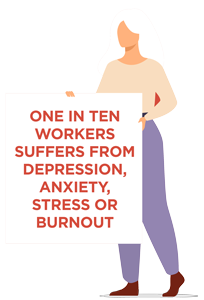Stress at the workplace today
Stress is the body’s physiological response when confronted with a situation perceived to be threatening or overly demanding. When this natural response becomes excessive, tension builds up and this has a direct impact on the body, leading to physical or psychological illnesses, such as anxiety, depression, heart disease, gastrointestinal or musculoskeletal disorders, etc.
Over the last few years, technological, organisational and communication changes that have been ushered as a result of economic globalisation have had a profound impact on the working environment and employment in general.
Men and women workers throughout the world have had to adapt to new types of work organisation and processes, new patterns of work (reduction in staff numbers, outsourcing, flexibility and mobility), higher workloads and more precarious jobs.
The repercussion of these changes on the mental health of workers is such that, according to the ILO, as many as one in ten workers suffers from depression, anxiety, stress or burnout which lead, in some cases, to unemployment and hospitalisation. As in other areas, women are the most vulnerable group since they are already exposed to specific stress factors as a result of the work they perform, their position in the organisational hierarchy, discrimination, sexual abuse and gender-based violence. This is compounded by the double or even triple burden they must bear (in the household, at the workplace and as carers for their families and relatives).



Stress and risk factors at the workplace
The sources of work-related stress affect men and women alike. However, the latter are disproportionately exposed to stressors due to the division of labour, household responsibilities, the lack of professional development opportunities, discrimination, sexual abuse and mistreatment at the workplace.
Some of the sources of work-related stress are:
 High pace of work.
High pace of work. Working to tight deadlines.
Working to tight deadlines. Short and repetitive tasks.
Short and repetitive tasks. Monotonous work.
Monotonous work. Lack of control over tasks.
Lack of control over tasks. Lack of control over work methods.
Lack of control over work methods. Little support form colleagues.
Little support form colleagues. Little support from supervisors.
Little support from supervisors. Long working hours.
Long working hours. Shift work.
Shift work. Harassment and discrimination.
Harassment and discrimination. Intimidación, violencia.
Intimidación, violencia. Job insecurity.
Job insecurity. Low pay.
Low pay. Lack of promotion prospects.
Lack of promotion prospects. Work of low social value.
Work of low social value.
The need for prevention
Employers and workers representatives must address the task of preventing the apparition of mental issues among workers. They must also provide the means to help those suffering from mental disorders to reintegrate into employment.
To achieve this, it is necessary:
 To recognise mental health as an area of interest for employers who should develop policies and action guides on the subject.
To recognise mental health as an area of interest for employers who should develop policies and action guides on the subject. To implement policies that eliminate unhealthy work environments, discrimination and workplace abuse, as well as adopt labour market integration policies for the disabled, in particular for those suffering from a mental health disorder.
To implement policies that eliminate unhealthy work environments, discrimination and workplace abuse, as well as adopt labour market integration policies for the disabled, in particular for those suffering from a mental health disorder. Implement programmes of prevention, treatment and rehabilitation.
Implement programmes of prevention, treatment and rehabilitation.
